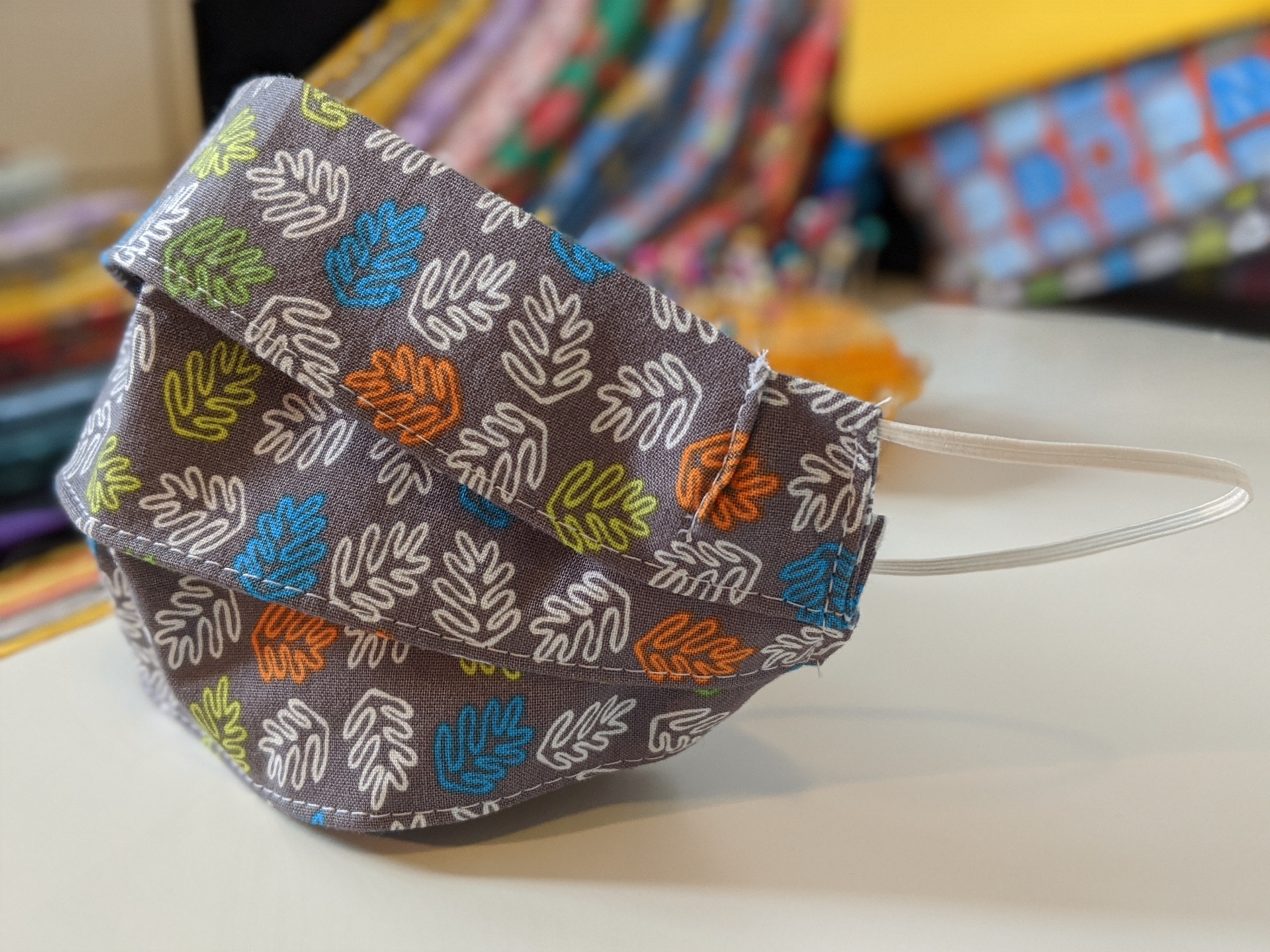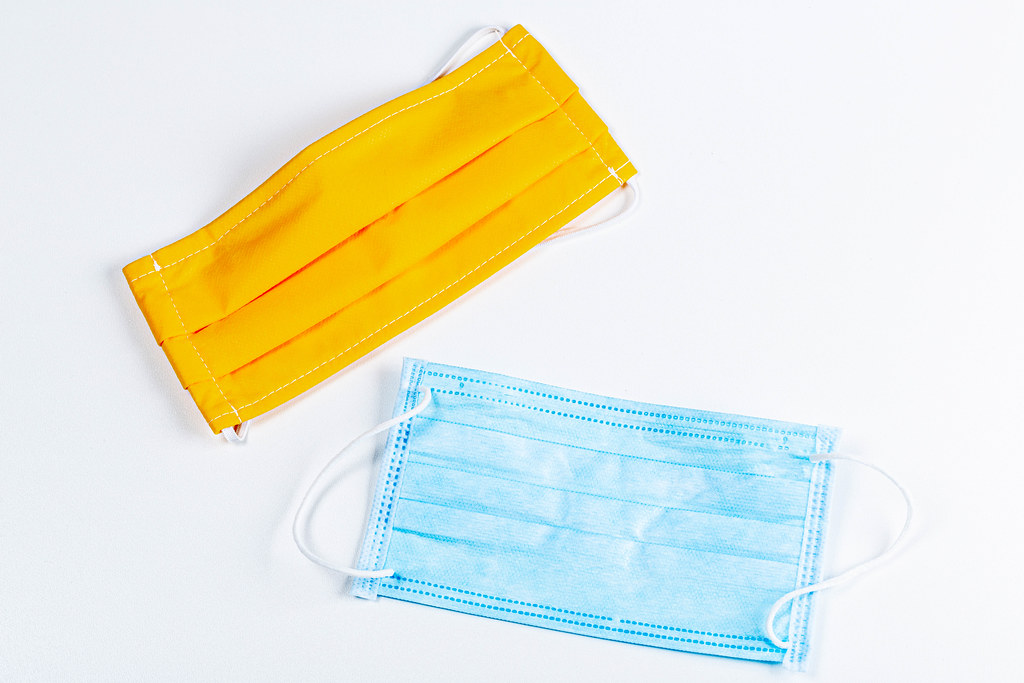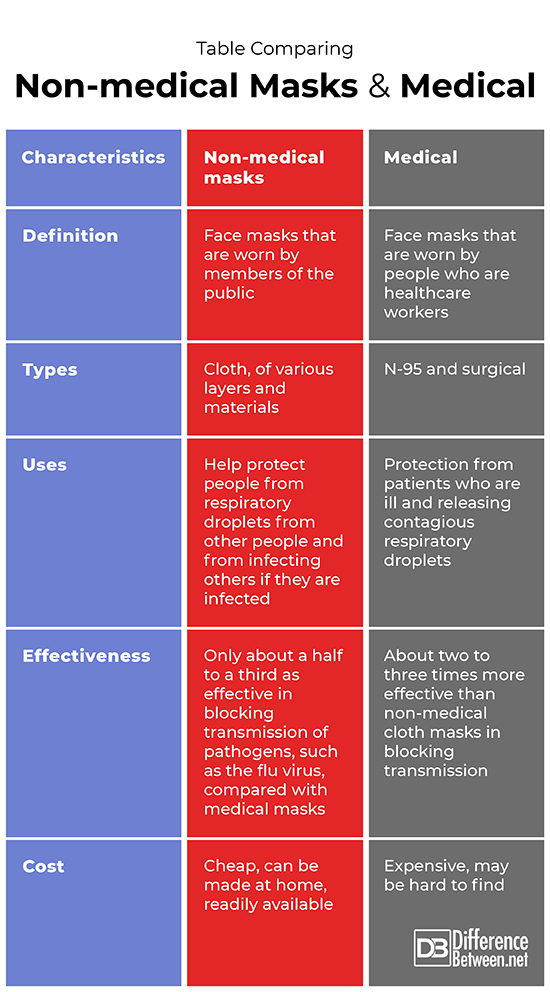Difference Between Non-Medical Masks and Medical
Non-medical masks are masks that the general public wears on the face, and these are usually made of cloth. Medical masks are special masks that healthcare workers wear and they usually are not made of cloth.

What is Non-medical mask?
Definition:
A non-medical mask is a type of face covering that is worn by the general public, generally while out and about in public.
Type of non-medical masks:
Non-medical masks can include cloth masks of various types. People make masks out of cotton, or even out of socks. Some countries have requirements for non-medical masks in which they recommend a cloth mask be at least three layers thick. They should be cleaned often and fit properly but should not fit in a way where the person cannot breathe properly. The mask should be worn so that both the mouth and the nose are completely covered. The mask can be designed to fit over the ears or the head.
When non-medical masks should be worn:
In general, non-medical masks are useful when a person is out in public and unable to avoid being around other people. This means that when shopping or using public transport, a mask should be worn to help prevent the spread of the COVID-19 virus. The idea is to stop your secretions from being expelled into the air, but also hopefully it can prevent secretions from others reaching your nose and mouth.
Limitations:
Non-medical masks are most often made of cloth of some sort and their ability to block secretions and virus particles is extremely limited compared with medical type masks. They do, however, offer some degree of protection, but it is important to remember that it is not a guarantee and other measures such as maintaining social distance, frequent hand washing, and not touching your face, are still important.

What is Medical mask?
Definition:
A medical mask is a type of face covering that is worn by the medical personnel as part of their personal protective equipment or PPE.
Type of medical masks:
Surgical masks and N-95 masks are the common types of medical masks that are used. These masks are made from various materials, and they filter out a lot of particles; the N-95 mask in particular is recommended as protection for healthcare workers dealing with COVID-19 patients. These masks are designed to filter out 95% of particles.
When medical masks should be worn:
Healthcare workers include doctors, nurses, radiologists, and others involved in the medical care of individual patients. The medical masks, along with other personal protective equipment should be worn when in the hospital or other healthcare setting. This is to reduce the risk of infection of the healthcare worker who is most likely to come into contact with sick individuals who are actively sneezing and coughing out virus-laden respiratory secretions of COVID-19.
Limitations:
Medical masks are better at blocking viruses and secretions than non-medical masks but will be more difficult to obtain and will be more expensive to buy. Even with PPE such as medical masks, some doctors and nurses have still been infected by their patients, and thus, such masks also do not offer complete and total protection from infection by COVID-19.
Difference between Non-medical masks and Medical?
Definition
Non-medical masks are face masks that are worn by members of the public and often made by individuals in the community. Medical masks are manufactured and specifically worn by healthcare professionals.
Types
Cloth masks are the type of non-medical mask most often seen. The surgical mask and N-95 are the two main types of medical mask being used by healthcare workers in the COVID-19 pandemic.
Uses
Non-medical masks are used by members of the public to protect people from respiratory droplets from other people and from infecting others if they are infected. Medical masks are used for protection from patients who are ill and releasing respiratory droplets that likely contain viral particles.
Effectiveness
Non-medical masks are only about one half to one third as effective at blocking the transmission of viruses such as the flu virus. Medical masks are about twice to three times more effective at blocking the transmission of viruses such as the flu virus.
Cost
A non-medical mask is cheap and easily available in the community. A medical mask is much more expensive and not so easy to find.
Table comparing Non-medical masks and Medical

Summary of Non-medical masks Vs. Medical
- Non-medical and medical masks are both face coverings to help protect against the COVID-19 and other viruses.
- No mask offers 100% protection against viruses, even if it is a medical mask.
- Non-medical masks are made of cloth and easy to find and make but are not amazingly effective.
- Medical masks include the N-95 and surgical masks and are more expensive and harder to find.
- Medical masks are more effective in blocking viruses such as the flu, and potentially COVID-19.
- Difference Between Rumination and Regurgitation - June 13, 2024
- Difference Between Pyelectasis and Hydronephrosis - June 4, 2024
- Difference Between Cellulitis and Erysipelas - June 1, 2024
Search DifferenceBetween.net :
Leave a Response
References :
[0]Davies, Anna, et al. "Testing the efficacy of homemade masks: would they protect in an influenza pandemic?" Disaster medicine and public health preparedness 7.4 (2013): 413-418.
[1]Feng, Shuo, et al. "Rational use of face masks in the COVID-19 pandemic." The Lancet Respiratory Medicine 8.5 (2020): 434-436.
[2]MacIntyre, Chandini Raina, et al. "A cluster randomized clinical trial comparing fit‐tested and non‐fit‐tested N95 respirators to medical masks to prevent respiratory virus infection in health care workers." Influenza and other respiratory viruses 5.3 (2011): 170-179.
[3]Image credit: https://www.publicdomainpictures.net/pictures/330000/velka/masques-artisanales-1586967707Z00.jpg
[4]Image credit: https://live.staticflickr.com/65535/49918274971_5be5eab3ef_b.jpg
